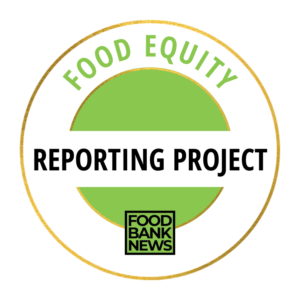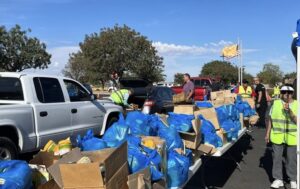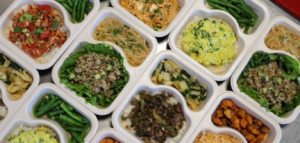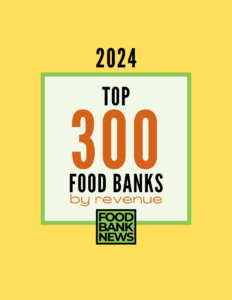When Hurricane Florence hit North Carolina three years ago, the Food Bank of Central and Eastern North Carolina realized it wasn’t as prepared to serve the Latino community as it should have been. “We rushed to say, ‘Here’s everything that we have,’ but that relationship wasn’t quite there,” said Jessica Slider Whichard, Vice President of Communications. “The trust in our organization — as a group that was there to help — wasn’t there. We realized that more needed to be done. We were falling short.”
Three years later, that reality is different. The food bank now has a partnership program to help it reach the Latino community, as well as more Spanish-speaking staffers, including a bi-lingual benefits outreach coordinator. Plus, it’s providing culturally relevant food, as well as services like access to translated documents.

The 62 million Latinos in the United States are particularly vulnerable to food insecurity. Northwestern University’s Institute for Policy Research found in a July 2020 report that 37% of Hispanics said they had been food-insecure in the prior week, a significantly higher percentage than the 23% of white respondents.
The Food Bank of Central and Eastern North Carolina is addressing the need in its area by working with nine partner organizations on a pilot program that delivers food boxes to the Latino community. Each organization works with 50 families, supplying around 450 boxes a month that contain items like canned chicken, canned beans and corn, tortillas, rice and cereal.
Milagros Guzman, Benefits Outreach Coordinator, explained that the food bank determined which products to include in each box with the help of two main partners: Farm Labor Organizing Committee (FLOC) and the Association of Mexicans in North Carolina (AMEXCAN), which developed a survey of the foods most desired by the Latino community.
“We developed these partnerships,” Guzman said. “And they have upgraded us to uplifting the voices of the Latino community, versus us telling what we can offer. We’re having that conversation.”
Thanks to the pilot program and other initiatives, the food bank served 64,000 Latino people in the last year — 23% of everyone the food bank helped. In addition, translating its pantry locator service into Spanish increased traffic to the webpage by 10%. Now, the entire website is available in Spanish.
The Capital Area Food Bank uncovered some eye-opening data when it found in its Hunger Report 2021 that more than 50% of people seeking food assistance for the first time during the pandemic were Latino, compared to just 16% before the pandemic.

“Of the newly food-insecure, almost 70% work,” said Radha Muthiah, President and CEO of the D.C.-area food bank. “Most people probably had multiple jobs before the pandemic to make ends meet, and then they lost either one or two of those jobs.”
Lack of knowledge about food-assistance services makes the problem worse. Of the most severely food-insecure, Capital Area Food Bank found only 25% are receiving SNAP and only 25% are aware of more than one location to access free food.
“If they are aware, they’re concerned about their immigration status,” Muthiah said. “They’re concerned that asking for support through these programs might jeopardize their future immigration status.”
When Capital Area Food Bank inquired about the main barriers to being able to afford food, 39% of respondents cited the ability to earn a living wage and 29% noted the high cost of housing. Learning new skills that will result in higher pay is a priority for Latino workers, the food bank found.
The food bank is addressing this concern through its Food+ Skills Development program, which provides no-cost food to encourage attendance at skills-development classes. “With their immediate food needs met, participants can more easily make time for skills development and set longer-term career goals,” the food bank said on its website.
Also a priority for Capital Area are recipe cards that focus on meals that are appealing to the Latino community, like tortilla soup or Mexican lime coleslaw. In addition, the food bank is increasing the number of Spanish-speakers on its team, and fluency is now required for some positions.
In Southern California, the Foodbank of Santa Barbara County was motivated to resolve a conundrum: The mostly Latino workers who produce the fresh fruits and vegetables for which the area is famous couldn’t afford enough healthy food to feed their families. Santa Barbara has the highest number of farm workers in the country (around 20,000), and the other county the food bank serves has about 13,000. “It’s painful, hypocritical and ironic,” said Judith Smith-Meyer, Senior Communications Manager.
So in July 2020, the Foodbank launched the Healthy Farmworkers program in partnership with Community Health Centers, a nonprofit that provides healthcare to under-served populations. With census data, community information and the help of CHC, the food bank was able to overcome the farmworkers’ biggest obstacle to food security: accessibility.
Since workers often carpool in vehicles with no room for food boxes, the food bank decided to go to the workers near their homes, establishing four food distribution sites in areas with heavily Latino populations. Distributions occur late in the afternoon so workers can attend with their families after work. The distributions, which also include nutrition and healthcare education, were so successful that they soon became monthly rather than every other month.
In another first-of-its-kind effort, the food bank has produced educational resources, including a YouTube video, in Mixtec, an indigenous language originating in Mexico spoken by many farmworkers in Santa Barbara County. — Mariel Lozada
Mariel Lozada is a Venezuelan journalist living in New York City. She is currently enrolled in the M.A. in Engagement Journalism at CUNY and works as the Spanish Assistant Editor for the Global Investigative Journalism Network.
CAPTION ABOVE: Members of the Association of Mexicans in North Carolina (AMEXCAN) with a van that the Food Bank of Central and Eastern North Carolina helped purchase.
Like what you’re reading?
Support Food Bank News







